NCC: Land Lines – Learning to love wetlands
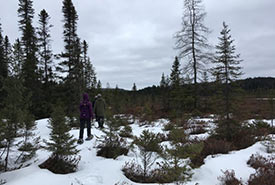
Crossing bogs in Algonquin Park to study Canada jays (Photo by Sam Knight/NCC staff)
For a few years I looked forward to February because it was the start of the Canada jay research season at Algonquin Park and I assisted with the field work. At that time of year, we crossed frozen bogs to check up on the birds, yet the spring melt made it much more challenging to navigate. This February, I think fondly of those frozen wetlands and the biodiversity they sustained, even in the coldest months, through the spring melt and into the abundance of summer.
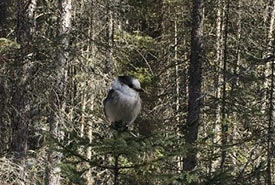
Canada jay (Photo by Sam Knight/NCC staff)
February 2 marks World Wetlands Day. The focus is a call to action to value, manage and restore wetlands. We have lost or degraded nearly 90 per cent of wetlands since the 1700s, and they are being lost three times faster than forests. Yet wetlands are vital ecosystems that support high biodiversity and provide many benefits to humans. It has only been over the past few decades that there has been a recognition of their importance and their subsequent conservation and restoration.
What exactly is a wetland?
Wetlands are areas that are either covered or saturated with water for at least part of the year. They are neither completely dry nor completely underwater, but are rather a transition zone between the two.
Wetlands are found around the world, from the high Arctic to the tropics, on every continent except the Antarctic. They exist in all kinds of climates, from the Mojave Desert to mountain peatlands, tropical Hawaii and prairie potholes. Wetlands can contain fresh water or salt water.
There are three major kinds of wetlands: swamps, marshes and peatlands. Swamps are permanently saturated with water, dominated by trees and are common in tropical areas. Marshes are typically found at higher latitudes than swamps and are flat landscapes dominated by grasses and aquatic plants. Moving to even higher latitudes (or altitudes), we find peatlands (bogs and fens), which are common in cold climates. This type of wetland is dominated by mosses, grasses, sedges and peat (partially decayed vegetation).
The importance of wetlands
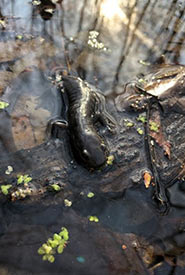
Endangered Jefferson salamander research at a vernal pond in southern Ontario (Photo by Sam Knight/NCC staff)
In Canada, wetlands are everywhere, covering 14 per cent of the land. It’s no wonder I constantly come across them during field work and hikes. Twenty-five per cent of the world’s wetlands are found here and 37 of Canada’s wetlands have been designated as Wetlands of International Importance. Peatlands make up 90 per cent of Canada’s wetlands, almost half of which are frozen year-round and known as permafrost.
Wetlands are biodiversity hot spots, providing habitat for a variety of plants and animals across Canada. Without wetlands, some of these species would disappear. My fondest memories of wetlands feature the unique sounds of common nighthawks foraging for flying insects over marshes in Ontario and the acrobatic foraging of tree swallows over marshes in British Columbia. Or the prairie potholes the American avocets visited, close to where I grew up in Alberta. And there is nowhere more iconic to see a moose than in a northern bog. I even helped out with endangered Jefferson salamander research at a vernal pond in southern Ontario. And it’s not just animals, but unique plants, that flourish in this habitat. One of my favourite plants to find in Nova Scotia bogs is the carnivorous purple pitcher plant.
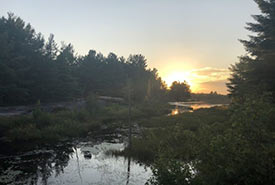
Crossing a marsh at Torrance Barrens to study nightjars (common nighthawk pictured) (Photo by Sam Knight/NCC staff)
Wetlands are also carbons sinks, meaning they absorb carbon dioxide from the atmosphere. Peatlands around the world alone store nearly 25 per cent of all soil carbon (more carbon than all of the world’s forests) even though they only cover three to four per cent of land.
Peatlands can act as fire breaks because they contain fire-resistant sphagnum moss.
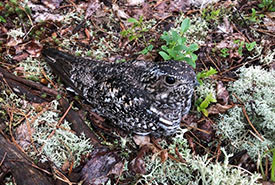
Common nighthawk (Photo by Sam Knight/NCC staff)
Wetlands filter pollutants out of water, thereby purify it. In southern Ontario alone, wetlands provide and estimated $4.2 billion worth of filtration services, according to a recent study. By storing this water, they provide a ready supply of drinking water. They also act as a natural sponge to absorbs excess water after heavy rain or snowmelt, providing flood control and reducing erosion. They slowly release this water over the dry season, reducing the effects of drought. In coastal areas, wetlands act as a buffer by protecting coasts from erosion by waves or storm surges. Human livelihoods not only depend on these ecosystems, but they also save lives.
Conservation efforts
The good news is that wetlands are being protected and they can be restored. The Nature Conservancy of Canada (NCC) has protected more than 109,000 hectares of wetlands across Canada directly and through partnership. One of our common restoration practices is to “rewet” wetlands that have been drained. But we have much more work to do. With our previous successes, we have demonstrated that we are ready to do even more to attain the larger conservation results needed to ensure a sustainable future where wetlands and the animals (including humans) who depend on them thrive.
Learn more about our wetland work in British Columbia, Manitoba, Ontario and Atlantic Canada.




